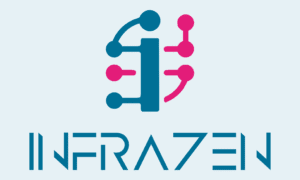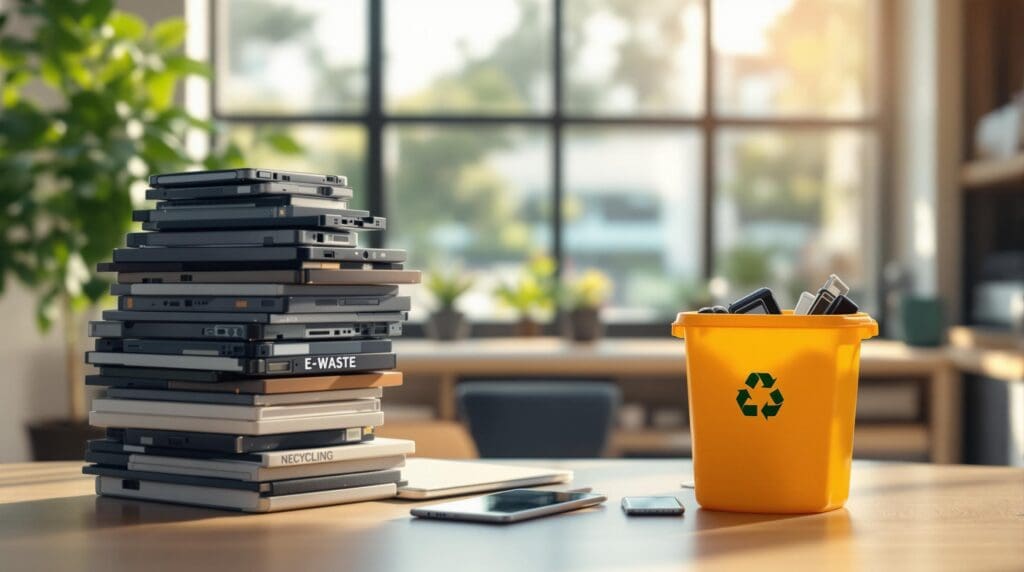E-waste is a growing problem, and proper IT asset disposal (ITAD) can help reduce its impact while protecting sensitive data. Businesses frequently upgrade technology, but mishandling old devices can lead to pollution, data breaches, and legal issues. Here’s what you need to know:
- E-Waste Facts: In 2019, 53.6 million metric tons of e-waste were generated, but only 17.4% was recycled properly. Toxic materials like lead and mercury in electronics harm the environment if not disposed of correctly.
- Business Risks: Poor ITAD practices can result in fines, lawsuits, data breaches, and reputational damage. For example, Morgan Stanley was fined $60 million in 2020 due to improper disposal.
- Solutions: Reuse equipment, recover valuable materials, and follow ITAD regulations like GDPR and WEEE. Certified data wiping and physical destruction ensure security.
- Choosing an ITAD Provider: Look for certifications (e.g., R2, ISO 14001), secure data handling, and strong environmental practices.
Proper ITAD not only reduces e-waste but also protects businesses from financial and legal risks. Start by auditing your IT assets and implementing clear ITAD policies.
Key Risks in IT Asset Disposal
Improperly disposing of IT assets can lead to two major problems: pollution and data security issues. Both can have serious consequences if not handled correctly.
Pollution and Material Hazards
IT equipment often contains harmful substances that can damage the environment. Here’s a breakdown:
| Toxic Material | Location | Environmental Impact |
|---|---|---|
| Lead | Circuit boards, CRT monitors | Contaminates soil and water systems |
| Mercury | Flat-screen displays | Harms aquatic ecosystems and enters the food chain |
| Cadmium | Rechargeable batteries | Causes kidney damage and weakens bones |
| Brominated flame retardants | Plastic casings | Builds up in the environment over time |
| Beryllium | Connectors | Can cause lung diseases when inhaled |
These materials don’t break down easily and can pollute soil and water for decades. In 2022, only 22.3% of e-waste was recycled properly, and this rate is expected to drop to 20% as disposal volumes increase . But the risks don’t stop at environmental damage – there’s also the issue of data security.
Data Security Risks
Beyond pollution, improper IT asset disposal can expose sensitive data. For example, in 2006, Idaho Power Company faced a breach when old hard drives were accidentally sold on eBay. This mistake exposed private information for 2,900 customers and employees, leading to a $50,000 fine and stricter security protocols.
Organizations face several key risks when it comes to data security:
| Risk Category | Potential Impact | Required Action |
|---|---|---|
| Data Breaches | Identity theft, financial fraud | Use certified data wiping methods |
| Regulatory Violations | Fines up to €20 million (GDPR) | Maintain compliance documentation |
| Intellectual Property | Loss of competitive edge | Physically destroy storage devices |
| Legal Liability | Lawsuits from affected parties | Keep detailed custody records |
To ensure data is completely removed, companies should layer their defenses. This includes encryption, certified data erasure software that follows standards like DoD 5220.22-M or NIST 800-88, and physical destruction when needed. Verification is critical, as improperly wiped devices often still contain sensitive data.
Steps to Reduce E-Waste
Businesses can address e-waste by reusing equipment, recovering materials, and following ITAD (IT Asset Disposition) regulations. Effective ITAD practices help minimize e-waste risks and recover value from outdated technology.
Equipment Reuse Options
Reusing devices can extend their lifespan and cut costs. For instance, Dell‘s closed-loop recycling program recovered 2.1 billion pounds of electronics in 2022, reducing raw material expenses by 21% .
| Reuse Strategy | Implementation Method | Business Benefit |
|---|---|---|
| Hardware Upgrades | Replace or enhance specific components | Saves money compared to purchasing new assets |
| Internal Redeployment | Assign devices to less demanding tasks | Maximizes the value of existing equipment |
| Employee Purchase | Sell refurbished devices at a discount | Lowers disposal costs |
| Verified Donations | Work with certified nonprofits | Offers community support and tax incentives |
Material Recovery Methods
Extracting materials from old IT equipment can deliver substantial value. For example, recycling 1 million cell phones yields 35,274 pounds of copper, 772 pounds of silver, 75 pounds of gold, and 33 pounds of palladium .
Here are some common recovery methods:
- Manual Disassembly: Carefully separates components to recover valuable metals .
- Automated Processing: Uses AI and mechanical shredding to handle large volumes while maintaining purity .
- Chemical Recovery: Employs hydrometallurgy to extract metals with lower energy use .
Meeting ITAD Rules
Compliance with ITAD regulations is crucial for managing e-waste effectively.
| Regulation | Requirement | Compliance Action |
|---|---|---|
| WEEE Directive | Ensure proper recycling | Partner with certified recyclers |
| GDPR | Securely erase data | Use reliable data wiping protocols |
| Basel Convention | Control hazardous waste movement | Keep a documented chain of custody |
| R2 Certification | Follow responsible recycling practices | Perform regular audits |
Organizations should document all disposals and conduct frequent audits to stay compliant. Employee training on ITAD procedures also helps prevent violations. Additionally, extended producer responsibility (EPR) laws in many countries now require manufacturers to manage their products’ full lifecycle . Following these rules not only protects sensitive data but also reduces environmental impact.
sbb-itb-70a39e2
How to Pick an ITAD Provider
Choosing the right ITAD (IT Asset Disposition) provider is essential for secure and responsible disposal of IT assets. With the global ITAD market projected to hit $31.8 billion by 2032, growing annually at 8.6% , it’s more important than ever to pick a provider that adheres to strict security and environmental standards. Once you’ve developed an effective ITAD strategy, the next step is finding a reliable partner.
What to Look for in an ITAD Provider
When assessing ITAD providers, focus on these critical qualifications:
| Requirement | What It Means | How to Verify |
|---|---|---|
| Industry Certifications | Certifications like R2, e-Stewards, ISO 14001/27001 | Ask for up-to-date certification documents |
| Data Security | Compliance with NIST 800-88 or DoD 5220.22-M | Review their security protocols and facilities |
| Chain of Custody | Clear tracking from collection to disposal | Check their documentation systems |
| Environmental Practices | Policies like zero-landfill and material recovery plans | Verify their downstream partnerships |
| Value Recovery | Ability to remarket and recycle assets | Evaluate their revenue-sharing models |
Also, ensure the provider uses advanced security measures like GPS tracking and 24/7 surveillance to protect assets. For example, Dell Technologies collaborated with TES in 2022 to handle 2.5 million IT assets, achieving a 95% refurbishment or recycling rate .
Providers who meet these benchmarks, like InfraZen, set the bar for high-quality ITAD services.
InfraZen‘s Approach to ITAD

InfraZen specializes in ITAD solutions in North East England, focusing on secure data destruction and compliance with environmental regulations. Their services include:
- Strategic Asset Management: Aligns ITAD with your overall IT lifecycle.
- Secure Data Handling: Uses certified protocols for data wiping.
- Comprehensive Documentation: Ensures detailed chain-of-custody records.
- Value Recovery: Maximizes returns through equipment refurbishment.
InfraZen also employs AI-driven monitoring systems to determine the best time for asset retirement, minimizing waste and boosting value recovery. Their approach ensures businesses comply with UK and EU regulations while maintaining cost-effective disposal strategies.
Regular audits and impact reports further bolster ITAD compliance, making it easier to stay on track with security and environmental goals.
Conclusion: Next Steps for IT Disposal
The growing e-waste problem is a pressing issue, urging businesses to move beyond reactive disposal and adopt smarter IT asset management practices.
To get started, consider these key steps:
- Conduct an Asset Audit
Take stock of all IT assets and their lifecycle stages. This helps pinpoint what needs to be disposed of and what can be reused or repurposed . - Establish ITAD Policies
Develop clear guidelines that address data security, compliance with environmental regulations, asset tracking, employee roles, and ways to recover value from old equipment. - Employee Training
Educate your team on secure disposal methods and data protection practices. This reduces the risk of mishandling IT assets.
By taking these actions, businesses can better manage IT asset disposal while tackling concerns like environmental harm and data security risks.
Success in ITAD can be measured by tracking metrics like reduced e-waste, improved asset recovery rates, and stronger data security. To stay effective, update policies regularly to keep up with new challenges and technologies.
Companies with well-implemented ITAD programs have reported saving 15-20% on their IT asset management budgets . For even greater benefits, explore a circular economy approach – this reduces waste and cuts costs by reusing and recycling IT assets effectively.
Turn IT asset disposal into a smart, cost-saving strategy starting today.
FAQs
Here are answers to some common questions that tie into the ITAD strategies mentioned earlier.
How can e-waste management be improved?
Managing e-waste effectively requires a mix of smart technology and practical methods. Some key strategies include:
- Collection Systems: Set up clearly marked bins in busy areas to make it easy for people to drop off old electronics. Large-scale programs have already managed to recover billions of pounds of e-waste this way.
- Digital Tools: Apps and online platforms can help track IT assets, schedule pickups, and educate users. IT asset management systems also play a role in ensuring devices are recovered for recycling.
- Advanced Recycling Methods: Facilities now use techniques like bioleaching and plasma arc recycling to extract materials like metals from old electronics.
These approaches help streamline the recovery and recycling process, making it both efficient and practical.
What are effective solutions for e-waste?
Addressing e-waste requires a well-rounded approach. Here are some solutions:
- Resource Recovery: Recycling efforts can yield significant returns. For instance, recycling 1 million cell phones can recover hundreds of pounds of valuable metals .
- Circular Economy Practices: Companies like Dell Technologies have incorporated over 100 million pounds of recycled plastic into new products, cutting down on the need for new materials by 35%.
- Corporate Partnerships: Working with certified ITAD providers ensures that disposal is both secure and environmentally responsible.
With the global e-waste recycling market expected to hit $63.5 billion by 2025, proper disposal isn’t just good for the planet – it’s also a growing economic opportunity.

